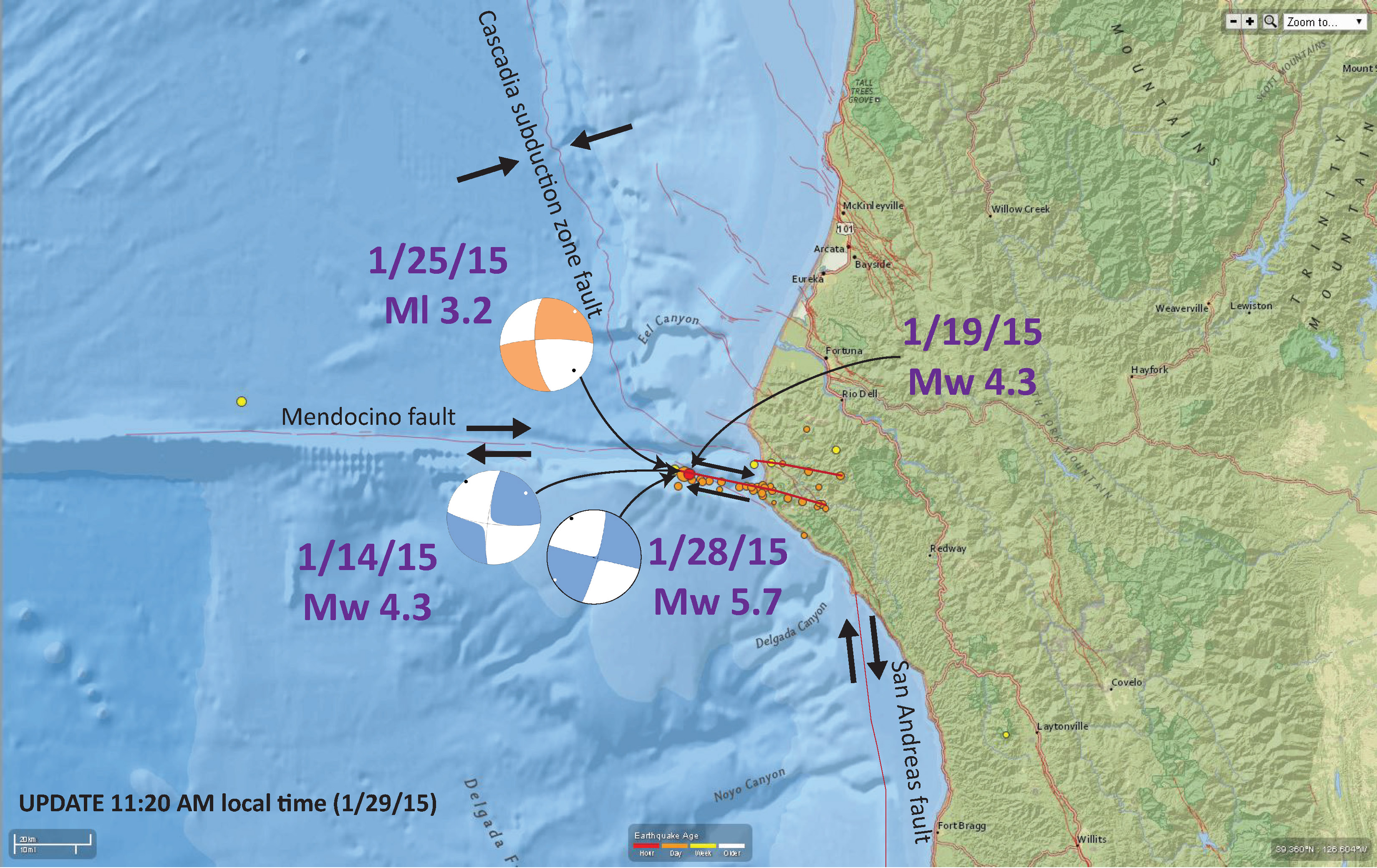The aftershocks continue following the Mw 5.7 mainshock earthquake swarm along the Mendocino fault. Yesterday I plotted my interpretation for the location of the fault that this swarm may have ruptured upon. Some epicenters have been relocated and appear to better align with the fault that I placed on my map.
Here is the map from this morning, updated at 9:22 AM local time. We just had a Mw 4.3 aftershock. If you felt it (or not!), please go here to report your observations. I have not edited the fault lines that I had plotted yesterday. You can compare this map with the map below, which I made around 9 PM last night.

Here is the map from last night, for comparison. Note how some epicenters have aligned more closely to the faults that I drew on the map yesterday. At first, I thought there might be an off-fault triggered swarm along a conjugate fault that strikes north-south. There are three epicenters on the eastern region of this swarm. However, since the locations have been updated (see above map), there is now only one of these off-fault epicenters remaining. So, it was my imagination.

-
Here are the USGS earthquake web pages for the larger magnitude earthquakes of this swarm that have focal mechanism or moment tensor fault solutions.
- Mw 4.3 foreshock
- Ml 3.2 foreshock
- Mw 5.7 mainshock
- Ml 3.1 aftershock
- Mw 4.3 aftershock
-
The Northern California Seismic System (NCSS) operated by UC Berkeley and USGS generated a series of probabilities for aftershocks related to the Mw 5.7 earthquake. This was updated this morning for version 3.
- STRONG AFTERSHOCKS (Magnitude 5 and larger) –
At this time (18 hours after the mainshock) the probability of a strong and possibly damaging aftershock IN THE NEXT 7 DAYS is approximately 19 PERCENT - EARTHQUAKES LARGER THAN THE MAINSHOCK –
Most likely, the recent mainshock will be the largest in the sequence. However, there is a small chance (APPROXIMATELY 5 TO 10 PERCENT) of an earthquake equal to or larger than this mainshock in the next 7 days. - WEAK AFTERSHOCKS (Magnitude 3 to 5) –
In addition, approximately 5 to 25 SMALL AFTERSHOCKS are expected in the same 7-DAY PERIOD and may be felt locally. - This probability report is based on the statistics of aftershocks typical for California. This is not an exact prediction, but only a rough guide to expected aftershock activity. This probability report may be revised as more information becomes available.
Is there a relationship between the Cascadia fault and the Mendo fault and if so how significant is it?
there sure is a lot of release going on……catalyst?
indeed, the southern CSZ and MF influence each other…
basically, when the MF slips, it increases the stress on the CSZ in some places and decreases the stress on the CSZ fault in other places. a Mw 5.7 would impart very little stress on the CSZ in either case. the imparted stress would also be short lived… generally, we would not expect that a 5.7 would trigger a large subduction zone earthquake on cascadia… unless the megathrust were just about ready to go.
the stress changes imparted by earthquakes are in the range of Pascals to kPa, while the stress that is released (from being stored) during an earthquake is in the range of MPa… (orders of magnitude greater). so, unless the fault is ready to go (called the stress state of the fault), coulomb stress interactions are unlikely to trigger earthquakes… the largest unknown is the stress state of the fault… especially Cascadia. we just do not know the stress state of the fault well enough to evaluate if the 5.7 would trigger an earthquake… we would only know as time passes…
i posted some material here>>> http://earthjay.com/?p=2123
Spooky – let’s all get prepared. The next one could come sooner than we hope.
always good to be prepared!